From picture books to novels, the offerings in this week’s column explore war and its impact on everyday lives. Some of the books deal with events and people in past wars or present-day conflicts around the world, while others consider war and its aftermath in general terms. The books approach the experiences and effects of war from various perspectives and are rich resources for encouraging discussion in classrooms.
Ages 4–8
The Day War Came. Nicola Davies. Ill. Rebecca Cobb. 2018. Candlewick.
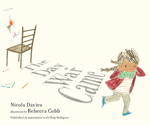 A young girl tells how she was in school on the day war came. “At first, just like a spattering of hail, / a voice of thunder . . . / then all smoke and fire and noise that I didn’t understand.” War is shown as an engulfing black cloud in Cobb’s expressive illustrations (done in pencil, colored pencil, and watercolor) as the girl moves through rubble to what was once her home. “War took everything. / War took everyone.” After making a long journey to a refugee camp, she discovers a school in the nearby town, but is turned away. There is no room for her. No chair for her to sit on. In despair, she huddles in a hut, until a boy offers a chair for her so that she can join his class. In an author’s note, Davies recounts an event in the U.K. that inspired this poetic story of a refugee child.
A young girl tells how she was in school on the day war came. “At first, just like a spattering of hail, / a voice of thunder . . . / then all smoke and fire and noise that I didn’t understand.” War is shown as an engulfing black cloud in Cobb’s expressive illustrations (done in pencil, colored pencil, and watercolor) as the girl moves through rubble to what was once her home. “War took everything. / War took everyone.” After making a long journey to a refugee camp, she discovers a school in the nearby town, but is turned away. There is no room for her. No chair for her to sit on. In despair, she huddles in a hut, until a boy offers a chair for her so that she can join his class. In an author’s note, Davies recounts an event in the U.K. that inspired this poetic story of a refugee child.
—CA
Marwan's Journey. Patricia de Arias. Ill. Laura Borràs. 2018. Minedition.
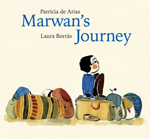 “I walk. . . / and I don’t know / when I will get there, / or where I am going.” A young boy named Marwan tells the story of his long, arduous journey crossing a desert sustained by dreams in which his mother says, “Marwan, keep going, walk, and walk, and walk” and by memories of his family and home before the night soldiers came “and swallowed up everything: / my house, my garden, my homeland.” With Patricia de Arias’ lyrical text and Laura Borràs’ striking ink and watercolor-wash illustration, this picture book is a child-friendly story of the world’s refugee crisis that ends with the boy’s arrival in another country, along with the hundreds of people with whom he has walked in “a line of humans like ants / crossing the desert.” For Marwan the future is uncertain, but he remains hopeful that one day he will be able to return to his homeland.
“I walk. . . / and I don’t know / when I will get there, / or where I am going.” A young boy named Marwan tells the story of his long, arduous journey crossing a desert sustained by dreams in which his mother says, “Marwan, keep going, walk, and walk, and walk” and by memories of his family and home before the night soldiers came “and swallowed up everything: / my house, my garden, my homeland.” With Patricia de Arias’ lyrical text and Laura Borràs’ striking ink and watercolor-wash illustration, this picture book is a child-friendly story of the world’s refugee crisis that ends with the boy’s arrival in another country, along with the hundreds of people with whom he has walked in “a line of humans like ants / crossing the desert.” For Marwan the future is uncertain, but he remains hopeful that one day he will be able to return to his homeland.
—CA
Mustafa. Marie-Louise Gay. 2018. Groundwood/House of Anansi.
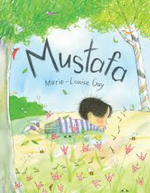 “Mustafa and his family traveled a very, very long way to get to their new country,” and he still has dreams of the war they fled. In this gentle story about a young refugee beginning to feel welcomed in his new home, Gay’s detailed, brightly colored, mixed-media illustrations show Mustafa exploring in the park near his apartment where he sees things that remind him of his old country but also feels invisible as he watches other children play. And then one day, the “girl-with-a-cat” who once spoke to him with words he could not understand, makes a come-with-me sign with her hand and takes him to the playground where they swing together. They introduce themselves—Ma-ri-a and Mus-ta-fa— and Mustafa doesn’t feel invisible anymore.
“Mustafa and his family traveled a very, very long way to get to their new country,” and he still has dreams of the war they fled. In this gentle story about a young refugee beginning to feel welcomed in his new home, Gay’s detailed, brightly colored, mixed-media illustrations show Mustafa exploring in the park near his apartment where he sees things that remind him of his old country but also feels invisible as he watches other children play. And then one day, the “girl-with-a-cat” who once spoke to him with words he could not understand, makes a come-with-me sign with her hand and takes him to the playground where they swing together. They introduce themselves—Ma-ri-a and Mus-ta-fa— and Mustafa doesn’t feel invisible anymore.
—CA
Ages 9–11
Lifeboat 12: Based on a True Story. Susan Hood. 2018. Simon & Schuster.
 In the summer of 1940, with London increasingly threatened by German bombings, the parents of 13-year-old Ken Sparks take advantage of a program to send him to Canada aboard the SS City of Benares, a passenger liner sailing in a convoy. Although sad to be leaving London, Ken is in the company of 89 children and delighted with the shipboard amenities and abundant food. When the liner is torpedoed about 600 miles from England, however, the adventure turns life threatening as the children scramble for lifeboats as the ship sinks. Based on a true story, Susan Hood’s suspenseful novel in verse recounts the survivors’ endurance of eight days at sea before they are rescued and returned to the U.K. The back matter includes extensive notes on facts behind Lifeboat 12, Hood’s sources and research, and archival photographs of people and details depicted in the novel.
In the summer of 1940, with London increasingly threatened by German bombings, the parents of 13-year-old Ken Sparks take advantage of a program to send him to Canada aboard the SS City of Benares, a passenger liner sailing in a convoy. Although sad to be leaving London, Ken is in the company of 89 children and delighted with the shipboard amenities and abundant food. When the liner is torpedoed about 600 miles from England, however, the adventure turns life threatening as the children scramble for lifeboats as the ship sinks. Based on a true story, Susan Hood’s suspenseful novel in verse recounts the survivors’ endurance of eight days at sea before they are rescued and returned to the U.K. The back matter includes extensive notes on facts behind Lifeboat 12, Hood’s sources and research, and archival photographs of people and details depicted in the novel.
—SW
A Story Like the Wind. Gill Lewis. Ill. Jo Weaver. 2018. Eerdmans.
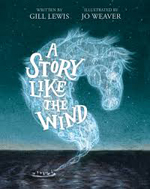 “In a small boat, with a small hope, in a rising wind, on a rising sea,” 14-year-old Rami uses his violin, the one thing that he could not leave behind when he fled the soldiers, to share a story with fellow passengers. It is the old story of a white stallion who raced like the wind and refused to be tamed by the Dark Lord and how the instrument called the morin khuur, the horsehead fiddle, was made to keep the story alive. Gill Lewis’ lyrical short novel, enriched by Jo Weaver’s expressive monochrome charcoal illustrations, is a moving and memorable story of shared remembrances and the hope for safety and freedom of six Middle Eastern refugees adrift at sea in a rubber dingy on a dark and windy night.
“In a small boat, with a small hope, in a rising wind, on a rising sea,” 14-year-old Rami uses his violin, the one thing that he could not leave behind when he fled the soldiers, to share a story with fellow passengers. It is the old story of a white stallion who raced like the wind and refused to be tamed by the Dark Lord and how the instrument called the morin khuur, the horsehead fiddle, was made to keep the story alive. Gill Lewis’ lyrical short novel, enriched by Jo Weaver’s expressive monochrome charcoal illustrations, is a moving and memorable story of shared remembrances and the hope for safety and freedom of six Middle Eastern refugees adrift at sea in a rubber dingy on a dark and windy night.
—CA
Winnie’s Great War. Lindsay Mattick & Josh Greenhut. Ill. Sophie Blackall. 2018. Little, Brown.
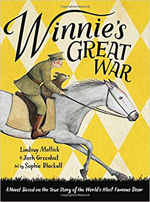 In 1914, when veterinarian Harry Colebourn travels east from Winnipeg on his way to the European front of World War I, he purchases a bear cub at the railroad station in White River, Ontario, from a hunter. And so begins the fabled life of Winnie, mascot of the Second Cavalry Infantry Brigade, in this whimsical novel written by Lindsay Mattick, Colebourn’s great granddaughter, and Josh Greenhut and illustrated with Sophie Blackall’s charming ink drawings. Winnie remains with the brigade until the men’s trench-warfare training in England, when a commanding general decides to use Winnie as a bomb-sniffing bear. Colebourn donates the bear to the London zoo, where she lives for more than 20 years and meets the son of A. A. Milne. Back matter includes archival photographs, entries from Harry Colebourn’s diary, and an author's note.
In 1914, when veterinarian Harry Colebourn travels east from Winnipeg on his way to the European front of World War I, he purchases a bear cub at the railroad station in White River, Ontario, from a hunter. And so begins the fabled life of Winnie, mascot of the Second Cavalry Infantry Brigade, in this whimsical novel written by Lindsay Mattick, Colebourn’s great granddaughter, and Josh Greenhut and illustrated with Sophie Blackall’s charming ink drawings. Winnie remains with the brigade until the men’s trench-warfare training in England, when a commanding general decides to use Winnie as a bomb-sniffing bear. Colebourn donates the bear to the London zoo, where she lives for more than 20 years and meets the son of A. A. Milne. Back matter includes archival photographs, entries from Harry Colebourn’s diary, and an author's note.
—SW
Ages 12–14
Escape from Aleppo. N. H. Senzai. 2018. Simon & Schuster.
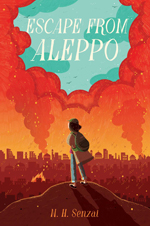 In 2013, 15-year-old Nadia and her family live under the constant threat of bombing of their Aleppo neighborhood. When their apartment is bombed, Nadia is separated from her family and she sets out on her own to escape to Turkey with hopes of being reunited with them. She learns to trust Ammo Mazan, a mysterious, elderly man and two destitute boys she meets, who help her get past thieves and through checkpoints and areas of continued bombing. In this suspenseful novel about courage and friendship, Nadia learns of Mazan’s underground work with scholars, government workers, and military officers to save and conserve Syrian cultural relics from destruction and the black market. An author’s note includes background information about events in the novel.
In 2013, 15-year-old Nadia and her family live under the constant threat of bombing of their Aleppo neighborhood. When their apartment is bombed, Nadia is separated from her family and she sets out on her own to escape to Turkey with hopes of being reunited with them. She learns to trust Ammo Mazan, a mysterious, elderly man and two destitute boys she meets, who help her get past thieves and through checkpoints and areas of continued bombing. In this suspenseful novel about courage and friendship, Nadia learns of Mazan’s underground work with scholars, government workers, and military officers to save and conserve Syrian cultural relics from destruction and the black market. An author’s note includes background information about events in the novel.
—SW
Nowhere Boy. Katherine Marsh. 2018. Roaring Brook.
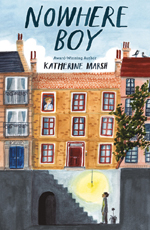 Fourteen-year-old Ahmed, an unaccompanied refugee from Syria, has been living in Parc Maximilien in Brussels with other refugee families, but when the park is closed and a smuggler steals his money and cell phone, Ahmed must scramble to find shelter. He hides in a complex of rooms in the cellar of a house, where 13-year-old Max and his family, visiting from America for a year, have taken residence. Max befriends Ahmed, and secretly, with his one friend and a boy who had bullied him, helps Ahmed achieve his deepest wishes, to go to school and to find his father in a country increasingly tense following terrorist bombings. In this suspenseful novel of friendship and unexpected heroes, Ahmed and Max discover courage and resourcefulness. The end matter includes a conversation with author Katherine Marsh, a resident of Brussels, in which she discusses her inspiration and experiences related to the refugee crisis that helped to shape the novel.
Fourteen-year-old Ahmed, an unaccompanied refugee from Syria, has been living in Parc Maximilien in Brussels with other refugee families, but when the park is closed and a smuggler steals his money and cell phone, Ahmed must scramble to find shelter. He hides in a complex of rooms in the cellar of a house, where 13-year-old Max and his family, visiting from America for a year, have taken residence. Max befriends Ahmed, and secretly, with his one friend and a boy who had bullied him, helps Ahmed achieve his deepest wishes, to go to school and to find his father in a country increasingly tense following terrorist bombings. In this suspenseful novel of friendship and unexpected heroes, Ahmed and Max discover courage and resourcefulness. The end matter includes a conversation with author Katherine Marsh, a resident of Brussels, in which she discusses her inspiration and experiences related to the refugee crisis that helped to shape the novel.
—SW
The War Outside. Monica Hesse. 2018. Little, Brown.
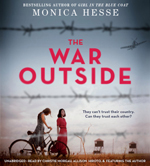 In 1944, Japanese–American Haruko, whose family is from Denver, and German–American Margot, whose family were farmers in Iowa, find each other in Crystal City, Texas, in an internment camp built to house Japanese, German, and Italian families. The two girls, who live in separate parts of the camp, face their doubts and suspicion of one another at school, but during a dust storm they seek shelter together in the ice house, which becomes their meeting place as they develop a secret friendship. However, Haruko believes her father is hiding a secret and Margot discovers her father’s Nazi sympathies, and after an accident at the community pool strains relationships among the residents, their friendship becomes increasingly tenuous in this novel of love and heartbreak. Back matter includes an informative “Note on Historical Accuracy” by the author.
In 1944, Japanese–American Haruko, whose family is from Denver, and German–American Margot, whose family were farmers in Iowa, find each other in Crystal City, Texas, in an internment camp built to house Japanese, German, and Italian families. The two girls, who live in separate parts of the camp, face their doubts and suspicion of one another at school, but during a dust storm they seek shelter together in the ice house, which becomes their meeting place as they develop a secret friendship. However, Haruko believes her father is hiding a secret and Margot discovers her father’s Nazi sympathies, and after an accident at the community pool strains relationships among the residents, their friendship becomes increasingly tenuous in this novel of love and heartbreak. Back matter includes an informative “Note on Historical Accuracy” by the author.
—SW
Ages 15+
The Unwanted: Stories of the Syrian Refugees. Don Brown. 2018. Houghton Mifflin.
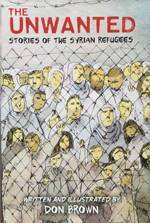 Using a graphic-novel format of panels of full-color artwork, blocks of text, and dialogue balloons, award-winning author/illustrator Don Brown effectively weaves together stories of refugees of the Syrian Civil War, which began in March 2011 as a revolution to overthrow the regime of President Bashar-al-Assad. In the intervening years, millions of people have fled the conflict and overwhelmed neighboring countries, while countless more have made desperate escapes to Europe. In a postscript, Brown addresses how the Syrian refugee crisis has “sparked a present-day backlash against immigration of all kinds and upended politics across the globe.” Back matter for this informative book that keeps the focus on the refugee experience includes Brown’s notes on his firsthand visits to refugee camps, source notes, an extensive bibliography, and the evocative poem, “Hope Behind the Shadow of Pain!” by Sahir Noah, and the painting, “Hope” by Salam Noah.
Using a graphic-novel format of panels of full-color artwork, blocks of text, and dialogue balloons, award-winning author/illustrator Don Brown effectively weaves together stories of refugees of the Syrian Civil War, which began in March 2011 as a revolution to overthrow the regime of President Bashar-al-Assad. In the intervening years, millions of people have fled the conflict and overwhelmed neighboring countries, while countless more have made desperate escapes to Europe. In a postscript, Brown addresses how the Syrian refugee crisis has “sparked a present-day backlash against immigration of all kinds and upended politics across the globe.” Back matter for this informative book that keeps the focus on the refugee experience includes Brown’s notes on his firsthand visits to refugee camps, source notes, an extensive bibliography, and the evocative poem, “Hope Behind the Shadow of Pain!” by Sahir Noah, and the painting, “Hope” by Salam Noah.
—CA
Sandip LeeAnne Wilson serves as professor in the School of Education and the English Department of Husson University, Bangor, Maine. Carolyn Angus is former director of the George G. Stone Center for Children's Books, Claremont Graduate University, in Claremont, California.
These reviews are submitted by members of the International Literacy Association's Children's Literature and Reading Special Interest Group (CL/R SIG) and are published weekly on Literacy Daily.